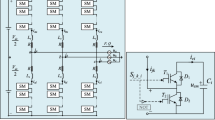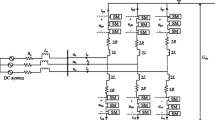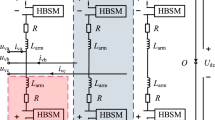Abstract
The cost of downtime and maintenance of any component of the offshore HVDC transmission system is higher than its equivalent onshore one. To prevent this, it is essential to detect any sign of hardware degradation and replace it with a healthy component. This paper presents a new way of detecting any possible deterioration of sub-module capacitance based on the measured feedback on the MMC-HVDC system. Here, the capacitor voltages are estimated using an analytical model and compared with the measured voltages. Initially, the method is verified with an independent sub-module during charging, closed-loop control, and discharge periods. It is then extended to a complete MMC-HVDC system during its operation. The simulation results demonstrate that the proposed method identifies the abnormal sub-module, isolates it, and replaces with a healthy, redundant module, without affecting the normal operation of the MMC-HVDC system.





















Similar content being viewed by others
References
Li B, He J, Li Y et al (2019) A review of the protection for the multi-terminal VSC-HVDC grid. Prot Control Mod Power Syst 4(1):1–11
Rahman S, Khan I, Alkhammash HI, Nadeem MFA (2021) Comparison review on transmission mode for onshore integration of offshore wind farms: HVDC or HVAC. Electronics 10(12):1–15
Li Z, Zhan R, Li Y, He Y, Hou J, Zhao X, Zhang X-P (2018) Recent developments in HVDC transmission systems to support renewable energy integration. Global Energy Interconnection 1(5):595–607
Ryndzionek R, Sienkiewicz Ł (2020) Evolution of the HVDC link connecting offshore wind farms to onshore power systems. Energies 13(8):1–17
Meng Y, Yan S, Kang Wu, Ning L, Li X, Wang X, Wang X (2021) Comparative economic analysis of low frequency AC transmission system for the integration of large offshore wind farms. Renewable Energy 179:1955–1968
Yang W, Tavner PJ, Crabtree CJ, Feng Y, Qiu Y (2014) Wind turbine condition monitoring: technical and commercial challenges. Wind Energy 17(5):673–693
Sessa D, S, Chiarelli A, Benato R, (2019) Availability analysis of HVDC-VSC systems: a review. Energies 12(14):1–22
Yin C, Deng F, Yu Q, Lv Y, Heng Q, Wang Q (2019) Capacitor monitoring for full-bridge submodule based modular multilevel converters. In: IECON 45th annual conference of the IEEE industrial electronics society, vol 1, pp 3781–3786
Wang Z, Zhang Y, Wang H, Blaabjerg F (2020) Capacitor condition monitoring based on the DC-side start-up of modular multilevel converters. IEEE Trans on Power Electronics 35(6):5589–5593
Zhao Z, Davari P, Lu W, Wang H, Blaabjerg F (2021) An overview of condition monitoring techniques for capacitors in DC-link applications. IEEE Trans on Power Electronics 36(4):3692–3716
Wylie J, Merlin MC, Green TC (2017) Analysis of the effects from constant random and wear-out failures of sub-modules within a modular multi-level converter with varying maintenance periods. In: 19th European conference on power electronics and applications ECCE Europe, Warsaw, pp 1–10
Zheng T, Huang M, Zhu L, Zha X (2019) (2019) Reliability evaluation of MMC system considering working conditions. J Eng 16:1877–1881
Turnbull A, Carroll J, Koukoura S, McDonald A (2019) Prediction of wind turbine generator bearing failure through analysis of high-frequency vibration data and the application of support vector machine algorithms. J Eng 2019:4965–4969
Yadav D, Pattnaik S (2019) A capacitor voltage balancing method in modular multilevel converter using selective mapping. In: IEEE students conference on engineering and systems (SCES), India, pp 1–5
Nanou S, Papathanassiou S (2017) Generic average-value modeling of MMC-HVDC links considering submodule capacitor dynamics. In: 52nd international universities power engineering conference (UPEC), pp 1–5
Ji S, Huang X, Palmer J, Wang F, Tolbert LM (2021) Modular multilevel converter (MMC) modeling considering submodule voltage sensor noise. IEEE Trans Power Electron 36(2):1215–1219
Jin E, Zhao J, Zhao L (2020) Improved precision MMC average equivalent model. In: IEEE international conference on high voltage engineering and application (ICHVE), pp 1–4
Pohjola M (2006) PID controller design in networked control systems, Master’s thesis, Helsinki University of Technology, Finland
Vrana TK, Yang YT, Jovcic D (2013) The CIGRE B4 DC grid test system, CIGRE WG B4.58. Electra 270:10–19
Wu G, Jun L, Zhou X, Li Y, Egea-Alvarez A, Li G, Peng H, Zhang X (2017) Analysis and design of vector control for VSC-HVDC connected to weak grids. CSEE Jl Power Energy Syst 3(2):115–124
Wu T, Wang X, Ma W, Li X, Chen D, Zhong J (2020) Control scheme of modular multilevel converter under unbalanced grid voltage. International forum on smart grid protection and control, lecture notes in electrical engineering. Springer 584:471–483
Beddard A, Barnes M (2015) Modelling of MMC-HVDC systems—an overview. Energy Procedia 80:201–212
Yadav D, Pattnaik S (2019) A capacitor voltage balancing method in modular multilevel converter using selective mapping. In: IEEE students conference on engineering and systems (SCES), Allahabad, India, pp 1–5
Li M, Wang Y, Zhu C, Xuan J, Wang C (2020) Reliability analysis based on MMC valve operating conditions in HVDC system. International forum on smart grid protection and control, lecture notes in electrical engineering. Springer 584:447–458
Konstantinou G, Pou J, Ceballos S, Agelidis VG (2013) Active redundant submodule configuration in modular multilevel converters. IEEE Trans Power Deliv 28(4):2333–2341
Wang S, Zhao X, Xue F, Li W, Peng H, Shi D, Wang S, Wang Z (2019) Electromechanical transient modeling of modular multilevel converter based HVDC network. In: IEEE sustainable power and energy conference (iSPEC), Beijing, China, pp 1845–1850
Meng X, Han J, Bieber LM, Wang L, Li W, Belanger J (2020) A universal blocking-module-based average value model of modular multilevel converters with different types of submodules. IEEE Trans Energy Convers 35(1):53–66
Guo D, Rahman MdH, Ased GP, Xu L, Emhemed A, Burt G, Audichya Y (2019) Detailed quantitative comparison of half-bridge modular multilevel converter modelling methods. J Eng 2019(16):1292–1298
Ronanki D, Williamson SS (2020) Failure prediction of submodule capacitors in modular multilevel converter by monitoring the intrinsic capacitor voltage fluctuations. IEEE Trans Ind Electron 67(4):2585–2594
Bapiraju J, Manohar P (2021) New analytical method for dynamic analysis an application to MMC-HVDC system. International Review of Modelling and Simulation (in press)
Author information
Authors and Affiliations
Corresponding author
Additional information
Publisher's Note
Springer Nature remains neutral with regard to jurisdictional claims in published maps and institutional affiliations.
Appendix
Appendix
1.1 Derivation of analytical method
Time domain solution to the state equation is derived using the final and initial values of the states and their derivatives. Derivation for nth order dynamic solution with application to MMC-HVDC system is presented in detail in another work [30], by the present authors. To make this paper self-explanatory, some of the details from this are covered here.
Consider state space matrix of sub-module with 3 states:
There are two sets of initial and final conditions of time domain solution, one set from (19) and the other set from inverse Laplace form. The final solution is obtained by equating both sets of initial conditions. The initial value of first-order derivative is obtained (19) as written as follows:
Continue to take derivative treating input to be constant and substitute the initial value:
In the steady state, the derivative becomes zero; therefore, final value from (19) for given input remains the same and is given by:
The second set of initial and final values of time domain solution is obtained from inverse Laplace form. Consider time domain solution, either in the eigenvalues (23) or with time constants (24):
Substituting final value in (24) as t → \(\infty \) reduces to:
Initial condition of (23) obtained by substituting t → \(0\), shown as in:
Initial value of first-order derivative of (23) calculated and simplified to:
Initial value of second-order derivative of (23) calculated from:
Separating coefficients of \({c}_{ij}\) from (26), (27) and (28) and simplifying by sending eigenvalue matrix on right hand side gives:
where \({\varvec{G}}={\left[\begin{array}{ccc}\begin{array}{c}1\\ 1\\ 1\end{array}& \begin{array}{c}{r}_{1}\\ {r}_{2}\\ {r}_{3}\end{array}& \begin{array}{c}{{r}_{1}}^{2}\\ {{r}_{2}}^{2}\\ {{r}_{3}}^{2}\end{array}\end{array}\right]}^{-1}\)
The result of (25) and (29) substituted into (23) to obtain the following:
where \({\varvec{E}}=\left[\begin{array}{c}{exp}^{\left({r}_{1}T\right)}\\ {exp}^{\left({r}_{2}T\right)}\\ {exp}^{\left({r}_{3}T\right)}\end{array}\right]\)
The final values and initial values of the derivative with state space matrices \(A\) and \(B\) are shown in (20) to (22) or (\({\varvec{X}}\left(\boldsymbol{\infty }\right),\boldsymbol{ }\dot{{\varvec{X}}}\left(0\right),\boldsymbol{ }\ddot{{\varvec{X}}}\left(0\right))\). These final values and initial values in (30) are replaced with values from in (20) to (22) to simplify further to:
where \({\varvec{K}}={\varvec{G}}.{\varvec{E}}\) \({\varvec{E}}=\left[\begin{array}{c}{exp}^{\left({r}_{1}T\right)}\\ {exp}^{\left({r}_{2}T\right)}\\ {exp}^{\left({r}_{3}T\right)}\end{array}\right]\)
The above equation is required to separate the coefficients of \({\varvec{X}}\left(0\right)\) and \({\varvec{U}}\left(0\right)\) to form simplified and final solution.
The calculated coefficients of \({\varvec{X}}\left(0\right)\) and \({\varvec{U}}\left(0\right)\), \({\varvec{P}}\) and Q respectively are given by:
The changes in electrical characteristics result in changes in values of matrix elements as matrices A and B derived using circuit parameter R, L and C. The matrices of P and Q are functions of matrices A, B, and K. Any change in parameter R, L and C results in change in the element in matrices of P and Q. The next state value \({\varvec{X}}\left(1\right)\) depends upon the matrices P and Q; therefore, it also reflects the same in the measurement signature. The order of the \(X\left(0\right)\) is 3 in this paper.
Rights and permissions
About this article
Cite this article
Bapiraju, J.V.V.N., Manohar, P. Detection and isolation of abnormal sub-module in an offshore MMC-HVDC system. Electr Eng 104, 1711–1724 (2022). https://doi.org/10.1007/s00202-021-01421-3
Received:
Accepted:
Published:
Issue Date:
DOI: https://doi.org/10.1007/s00202-021-01421-3




